The light blinks when the switch is off: causes and solutions
Energy-saving lighting devices are actively replacing old, wasteful incandescent lamps, because the positive effect of new technologies is obvious to all users.
Nevertheless, they also have their own characteristics; as a result, a person may be puzzled by some incomprehensible phenomenon. For example, sometimes it happens that a light bulb blinks when the switch is off. But it’s relatively easy to deal with this if you discover the true cause of the breakdown.
The content of the article:
Why are the lights blinking?
Modern lighting technologies allow you to save money and are designed for long-term operation. At the same time, high-tech products have a more complex design.
This is exactly the case with energy saving lamps. As a result, this feature sometimes leads to their abnormal operation. And everything is complicated by the fact that the user, encountering any malfunctions for the first time, does not know what to do. But in many cases problems are solved quickly and simply.
At least in the case of flickering, this is the case. And in order to understand why an energy-saving light bulb or a group of them periodically blinks when the switch is off, it is rather superficial to familiarize yourself with the individual design features of modern light sources.
So, you need to know that any device of this type can only operate on direct current.And it is supplied with an alternating supply voltage that needs to be converted. The diode bridge is responsible for this procedure, but after performing the desired operation, a current of the required voltage is obtained, but with high ripple.
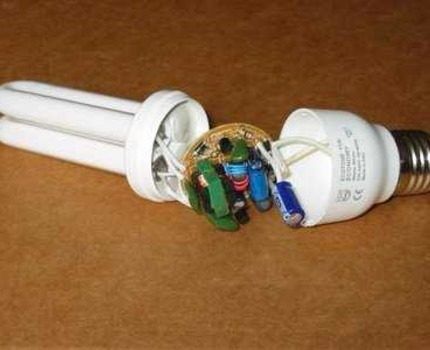
To smooth out existing fluctuations in energy-saving devices, a filter capacitor is used. During the passage of which the current reaches the required conditions and is supplied to the lamp starting circuit. After which the lamp used lights up. This happens when the entire chain is working properly.
But blinking when the switch is in the off position indicates that some kind of failure has occurred. And the reason for this is the accumulation of electricity by a filter capacitor designed to smooth out pulses.
The fact is that all the accumulated electricity, upon reaching a certain level, is supplied to the lighting device’s starting circuit. Next, the usual contact closure occurs and the supply voltage forces the light bulb to illuminate.
But since the energy charge in the filter capacitor is small, it is instantly consumed and the glow stops. As a result of this process, blinking occurs.
And then a new cycle of energy accumulation begins with its supply to the starting circuit and this can continue indefinitely, or rather, until the energy-saving lamp breaks down or the problem is eliminated.

Moreover, the reason described is the only possible one. That is, it can be unequivocally stated that blinking occurs only due to the accumulation of small amounts of electric current by the filter capacitor. Now you need to figure out where it comes from when the switch is in the off position.
Reasons for current accumulation on a capacitor
Despite the accumulation of electricity in the filter capacitor, in most cases it remains operational. And the very presence of current simply indicates a problem.
Its source can be 3 reasons:
- Backlight lamps located on the switch.
- Presence of leakage currents.
- The exhausted life of the lamp itself and its individual elements. For example, the starter of a fluorescent energy-saving lamp.
To solve the problem quickly and at low cost, you should take a closer look at the causes of flickering/blinking.
Reason #1 - switch backlight lamps
The industry is trying to increase the competitiveness of its products by making them more functional and convenient.
For this purpose, many switches are equipped with backlight lamps, which help people easily find their location in the dark. But the way they are connected to the circuit often allows current to flow to the filter capacitor, which will cause blinking.

This happens due to the fact that the backlight lamp is installed parallel to the switch itself. This is done so that this element can always perform its duties.
But when the switch contacts are open, all available electric current flows to the backlight.And then a small amount of it falls on the energy-saving lamp, which leads to abnormal operation of the filter capacitor. This phenomenon is so common that it has become the main cause of blinking.
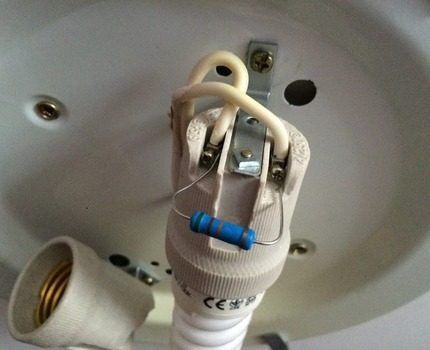
It is easy to combat this cause, and there are several simple methods from which a person can choose the appropriate one.
Method #1. Replacing the switch with a product without a backlight. It is not expensive and the problem can be fixed quickly.
Method #2. Disconnect the backlight wires - that is, you just need to break the power circuit by cutting the necessary wires. Any specialist or the user himself can do this in a few minutes if he has the appropriate skills. This solution is considered the most inexpensive, but you will have to sacrifice the lighting.
Method #3. Add an incandescent lamp - in this case, all the current from the backlight lamp will be spent on heating its filament. And since the supply of electricity is small, this will not lead to any results, but the filter capacitor will not blink.
The advantage of this option is that the backlight can be preserved, and the cost of elimination will be minimal. But the aesthetic properties of this method are questionable, since incandescent lamp it is problematic to disguise it in any chandelier.
Method #4. Add a low-power resistance to the circuit - this solution to fixing the problem is similar to the previous one. That is, the additional element will consume the entire supply of current, which is why it will not accumulate in the filter capacitor.
The recommended resistance power is 2 W, while the rating should be within 50 kOhm. This option is the least popular.
Method #4. Connect the backlight lamp to the wiring separately from the switch. Thus, it is possible to save the LED. But it will work constantly, that is, even in the on position of the switch, although the costs will be insignificant.
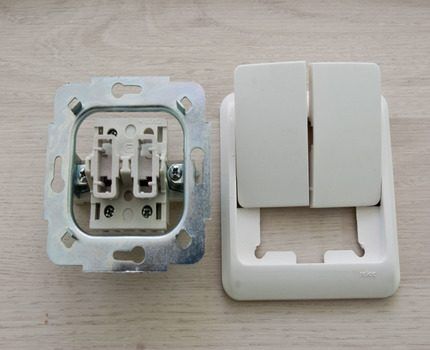
Despite its simplicity, the feasibility of this option is questionable; even for safety reasons, it is better for a person to get by with any of the previous methods.
Since the described case is the most common cause of electricity entering the filter capacitor, and, consequently, blinking energy saving lamps, then you need to start looking for the problem with it.
It may also be useful to know that modern switches use two types of backlight lamps: neon and LED. And most often it is the first type of lighting that leads to abnormal operation.
Reason #2 - presence of leakage currents
Often the wiring or other circuit elements are in poor condition. Which can lead to the formation of so-called leakage currents.
That is, despite the switch being turned off, electricity can again be supplied to the filter capacitor. As a result, the energy-saving lamp used blinks/flickers.

Such cases are less common than abnormal work backlight lamps, but this option can be much more dangerous. Since only serious reasons can lead to the appearance of leak points.
These include the following:
- Insulation damage.
- Incorrect electrical installation.
- Poor connection.
Any damage to the insulation may occur if low-quality wires or other circuit elements are used. And also resource depletion can lead to these consequences. That is, insulation is often destroyed due to its “venerable” age.
Incorrect wiring also often leads to the fact that when the circuit is broken by a switch, current will still flow to the lamp. This happens when the rules for performing work are grossly violated.
As a result, the switch breaks the so-called zero, but the phase that is not needed in this case. You can identify such an oversight yourself using a voltage indicator, which can be successfully replaced with an electrical clamp.
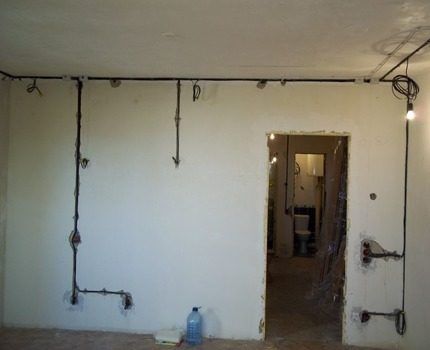
Poor electrical installation also often leads to leakage currents. This can happen due to a number of reasons. These include poor connection of wire cores or incorrect connection to other elements of the circuit. For example, poor contact between the wires and the switch connector.
The owner of the premises needs to understand that poor wiring poses a danger to the health and life of every person who is in it.This is especially true for situations where the old and inefficient Soviet TN-C system is used as grounding. Therefore, immediately after identifying any shortcomings, they must be eliminated immediately.
Reason #3 - exhausted lamp life
All kinds of modern lighting devices have a huge resource, but this too will someday be exhausted. Therefore, this reason for the blinking of the lamp should also be kept in mind, since this is not uncommon.
And the likelihood of such a problem becomes especially high when the energy-saving lamp has worked for several years. Moreover, a person should not be surprised that the manufacturer promised a service life of 10 years or more, but the malfunction appeared earlier.
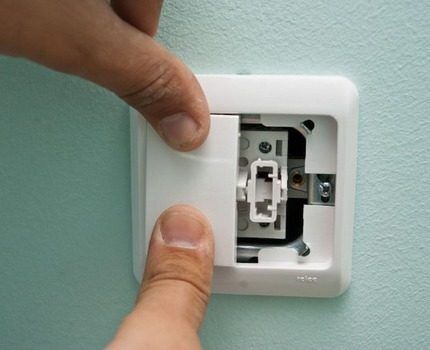
There are many objective reasons for early resource depletion. For example, these may be voltage surges, low or high temperatures, and other non-optimal conditions. By the way, blinking itself also leads to premature failure of any lighting device.
Most often, the cause of flickering of fluorescent energy-saving lamps with expired service life is a faulty starter. In this case, you can get out of the situation by simply replacing the specified element, especially since it is inexpensive.
It is also worth remembering that the buyer may receive a low-quality lighting device. To avoid this, it is necessary to purchase products from world-famous manufacturers.
For example, these are Philips, OSRAM and a number of others.Their products are more expensive than those from domestic or other manufacturers, including Chinese, but defects are extremely rare, and the performance characteristics correspond to the declared ones.
Independent search for the cause of the malfunction
If an energy-saving lamp used in a lamp or other product begins to blink, then you need to start fixing the problem immediately. Since each lighting device has resource limitations in terms of the number of starts.
That is, each such cycle reduces the operating time, and if they are repeated frequently, then in just a few days the service life will be reduced by many months, or even years. In addition, as mentioned above, if the wiring is faulty, there may be a threat to the health of the home owner, his family and friends, which should not be allowed.

The troubleshooting procedure should begin with the simplest methods that do not require costs. And if they don’t give results, then move on to more complex ones.
So, first of all, you need to check the functionality of the light bulb itself. Why can it be moved to another place, tested with neighbors and acquaintances. If the blinking continues, then you just need to replace the lighting fixture.
When, after installing the lamp in a new location, the malfunction does not appear, then it should be replaced. switch. In order not to waste money, you can take it from another place for testing and, preferably, it should be without a backlight. When the reason is identified, you should simply buy and install a new switch.
If this does not produce results, then the owner of the premises should look for a problem in the wiring. But when performing any electrical work, it is important to remember that all of it is potentially dangerous. Therefore, you need to follow measures to prevent and avoid risky situations, have sufficient skills and have the appropriate tools.
Information will help you find out the reason why the LEDs glow after disconnecting from the power supply. next article, which examines all the possible occurrences of such situations, as well as ways to eliminate and prevent them.
Conclusions and useful video on the topic
In the first video you can see how the lamp blinks and get additional information on what to do:
The following video describes one of the ways to fix the problem, namely replacing the filter capacitor:
Video about switch connection errors that can cause lamps to blink:
Understanding the reasons for the blinking of a light bulb when the power supply circuit is open is relatively simple. To do this, a person must have a moderate amount of special knowledge and skills. But it is necessary to look for the problem promptly, as well as to eliminate the identified shortcomings.
Since almost any malfunction can be potentially dangerous for people. In addition, untimely elimination leads to additional financial losses.
Please write comments in the block form below, ask questions, post photos on the topic of the article. Tell us how you determined the reason for the blinking light bulb. Describe how you resolved the problem.




I also encountered the problem of a light bulb flickering when the switch was in non-working mode, and the reasons were different twice. The switch was replaced once, and before that the old wiring was changed. But these are isolated cases, and most often the reason for the flickering of the lamp was the exhaustion of its resource. The fastest place for a lamp to fail is in the bathroom. Here's how to increase service life?
If light bulbs burn out in the same place, then this is a reason to think about the health of the lighting network in this room, in your case the bathroom. The reason could be, for example, poor contact in the socket or in the supply wire. This causes the voltage to jump and the light bulb to burn out faster. You need to check and change if necessary. You can also extend the life of an incandescent lamp by connecting it through a diode.
In the bathroom, Natalya, they usually use sealed lamps that protect the “filling” of the lighting fixture from moisture. Violation of heat dissipation leads to overheating of the lamps and they burn out more often than lamps in other rooms where open lamps are used. And one more thing - the frequency of lamp burnout is related to the number of on/off cycles. Incandescent lamps are more durable here. Change it and see the result.